PocketChess versus Chess Genius — a seven game match at various time controls
This is not a review, or even a full comparison, but rather a report on a chess match between the two major commercial chess programs available for the PALM OS:
– PocketChess 2.0, which costs $24.99
– Chess Genius 1.2, which costs $25.
There appears to be a significant difference in strength between these two programs.
These games were played on a Handspring Visor Prism with a 33 MHZ Dragonball processor. If you are serious about pda chess, you want as much processing power as you can get. Bear in mind that on a Palm III, more than three times more seconds would be needed for the same amount of analysis. (On recent palm models, a 20 mhz processor is more common, requiring about 60% more time than the prism for the same analysis.)
Basically, I set various time controls (usually different for each program) and played the two chess programs against each other. PocketChess was white in all but game five. After one program made its first move as white, I played that move in the other program. When that program made its move with black, I played that move in the first program, and so on. I usually stopped the games when the result seemed inevitable.
Chess Genius won the match with six wins, one draw and no losses, even though I gave it less time to move in most of the games. In general it seemed to make more aggressive moves. Both programs sometimes made very aimless moves, but CG was more likely to find some aggressive idea, rather than make an aimless move. Both programs are weak positionally, but respond very strongly (and sometimes with very natural moves) to an opportunity to win material or attack the king. The biggest weaknesses of CG (I think) are that it values its own king safety very lightly, and does not worry about giving its opponent strong passed pawns. Its biggest strength in this match seemed to be that it simply analyzed deeper (or more comprehensively) than PC.
Before I discuss the games, a few disclaimers:
- I was an A-rated player in my youth, but play at much lower strength now. I have a lot of experience and insight regarding computer chess play; but my comments on the games and the computer’s play are just the comments of a decent patzer; I will be happy to receive comments and corrections at [email protected] ..
- Unless you are at a solid C-rated player or better, you probably should not choose your chess program based upon its strength. You are unlikely to enjoy playing either of these programs at full strength, so other features will be more important.
- Chess Genius has a number of features that improve the experience of playing chess against the computer.
- PocketChess has many features geared to analyzing and playing over games (both in Windows and on the PDA); there is a companion windows program to extend its capabilities. These functions look excellent, but I have not tried most of them. I did use PocketChess’s Windows Chess Companion to play over the games and make diagrams of the positions for this article. I found it a pleasure to use. If you are serious about studying and improving your game, this may be the product for you.
- I own a copy of Chess Genius (“CG”), but have been using the unregistered version of PocketChess 2.0 (“PC”). (The unregistered version probably plays at full strength, but the registered version may have other features I’m unaware of.)
- My tests really do not prove anything. I just played a few games on one PDA model. The fact that one chess program beats another does not mean for sure that it can also beat many stronger players. There is no guarantee that both of these products would act the same on another PDA, or even on another Visor Prism. I just hope you will enjoy reading about the match as I experienced it.
- In a match where the allowed time per move for each program was very important, I am embarrassed to admit that due to editing errors, I may be reporting two time controls incorrectly. Game 1 was probably 30 seconds per move each, but might have been 15 each. Game three was probably as I reported it, 2 minutes against 30 seconds.
I shall confine myself mostly to comments about the games, but I have a few strong impressions about the programs as well:
- A convenient feature of Chess Genius is that you can turn the PDA off and on again, and it will pick up analyzing where it left off.
- If PocketChess is analyzing a move when a Date Book alarm goes off, I hear the alarm but never see the alarm screen; it gets swallowed up. If this is also a problem on Palm models, it’s a bug that ought to be fixed.
- CG can show you what it is currently analyzing, and how it evaluates the current position. This feature helped me understand a lot about what was happening in these games. (PC may have a similar feature, but I did not find it.)
- CG is always the cheerful optimist, assuming it has a small advantage in approximately even positions. (And maybe it does…)
- Both computer programs manage their time. If the time limit is nominally 15 seconds, the programs may take much more or less depending upon the situation. I assume they try to keep their average time fast enough to beat “time controls” at 40, 60… moves. CG is rather human in the way it moves quickly when the position is clearly in its favor, and slowly (up to three times the limit) when it is in trouble.
I’ve previously played PocketChess 1.1, and have recently played many games with CG 1.2. I felt that CG was stronger than the older PC 1.1, so I was eager to match the current versions up. Here’s a brief review of the match, followed by a long review of the games:
Game 1: 30 seconds per move. PC blundered in the opening and lost.
Game 2: PC 15 seconds per move, CG 5: hotly contested, CG won the endgame.
Game 3: PC two minutes to CG 30 seconds: CG played better in the opening and middle game, but PC managed to draw the late middle game, thanks to CG’s undervaluing (in my opinion) passed pawns.
Game 4: PC 90 seconds to CG 15: CG came from behind in the middle game and won in the endgame, despite being allowed much less time.
Game 5: CG played WHITE, each program got 2 minutes per move: PC got a strong opening position, CG gradually took over.
Game 6: PC 100 seconds to CG’s 10! CG was under heavy attack until about move 54, after which CG swindled away the game.
Game 7: blitz (one second per move). PC blundered in the opening and lost quickly.
Here are the actual game scores with notes. Again, please note that PocketChess has white in all games except game five:
____________________________________________________________________________________________________________________________
Game 1: PC vs. CG 30 seconds each per move.
PC blew a piece in the opening, and CG gradually ground out the win.
1. Nf3 c6 2. Nc3 d5 3. d3 e6 4. Bf4 Bd6 5. Be5 (a strange move)
Bxe5 6. Nxe5 d4 7. Qd2?? f6 8. Nc4 dxc3 9. Qxc3 Ne7 10. O-O-O O-O 11. e4 b5 12. Ne3 a5 13. Be2 Qd6 14. Kb1 a4 15. d4 Nd7 16. h3 Rd8 17. e5 Qb8 18. exf6 Nxf6 19. Qc5 Qd6 20. Qxd6 Rxd6 21. Bf3 Bb7 22. c3 a3 23. b3 Ned5 24. Rd3 Nf4 25. Rd2 N6d5 26. c4 Nc3+ 27. Ka1 Ra6 28. g3 Ng6 29. Re1 Ne5 30. Bg2 Nf7 31. cxb5 Nxb5 32. Nf5 Rd7 33. Rxe6 Nfd6 34. Nxd6 Rxd6 35. Re7 Nxd4 36. Bf1 Nc2+ 37. Kb1 Rxd2 38. Rxb7 Ra8 39. Bc4+ Kh8 40. Kc1 Rxf2 41. Rf7 Rxf7 42. Bxf7 Nb4 43. Kd2 Rd8+ 44. Kc3 Nxa2+ 45. Kc2 Nb4+ 46. Kc3 a2 *0-1
The final position, after 46. … a2 (Black will queen the rook pawn):
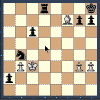
(Click on images for a larger view)
PC blundered away a knight for two pawns in the opening. CG made a remarkable number of pawn moves in the opening, then gradually strengthened its position and earned the victory. Moves and positions in this game were the most anti-human of the match; it really looked like a contest of two dimwit computers.
____________________________________________________________________________________________________________________________
Game 2:
PC (15 seconds per move) versus CG (only 5 seconds per move). CG swindled this game from PC.
1. d4 d5 2. c4 c6 3. Nf3 e6 4. cxd5 exd5 5. Nc3 Nf6 6. Ne5 Be7 7. e3 Nbd7 8. Nxd7 Bxd7 9. Bd3 Qc7 10. O-O Ng4 11. f4 O-O 12. Qc2 Nf6 13. Bd2 Bg4 14. Kh1 Bd6 15. Rac1 a6 16. Qb3 Qe7 17. h3 Bc8 18. Rf3 Ne4 19. Bxe4 dxe4 20. Rg3 Be6 21. d5 cxd5 22. Nxd5 Bxd5 23. Qxd5 Rfc8 24. Bc3 g6 25. Rd1 Bb4 26. Bd4 Rd8 27. Qh5 Rac8 28. a3 Bc5 29. b4 Bxd4 30. Rxd4 Rxd4 31. exd4 Rc3 32. Qg5 Qxg5 33. Rxg5 Rxa3 34. Re5 Ra1+ 35. Kh2 Rb1 36. Rxe4 Rxb4 37. g4 f5 38. gxf5 gxf5 39. Re8+ Kf7 40. Rh8 Kg6 41. Rd8 b6 42. Rd6+ Kg7 43. Kg3 Kf7 44. d5 a5 45. Rd7+ Kg6 46. Rd6+ Kh5 47. Rf6 Rb3+ 48. Kg2 Rd3 49. d6 Rd2+ 50. Kf3 a4 51. Ke3 Rd5 52. d7 Rxd7 53. Rxf5+ Kh4 54. Rb5 Rd6 55. Rb1 Re6+ 56. Kf3 Rf6 57. Ra1 b5 58. Rb1 Rb6 59. Ra1 Rb7 60. Rh1 b4 61. Ke4 b3 62. Kf3 b2 63. Rb1 a3 64. Rg1 Rb3+ 65. Ke4 a2 *0-1
This was a hotly contested game. CG was in continual trouble in the opening and early middle game (and knew it). Eventually, PC allowed simplifying exchanges, and then CG swindled a pawn. In the rook and pawns ending that followed, CG hit upon a strategy – hiding its king in the middle of the king rook file to minimize its exposure to checks. That might have enabled PC to queen its passed pawn in the middle of the board, but instead PC allowed that pawn to be exchanged for another of lesser value. After that, CG’s rook dominated PC’s rook and king, and it was easy for it to queen its queenside pawns.
After move 46, we see CG’s plan – hiding its king out of play to avoid checks:
Position after 46. … Kh5:
____________________________________________________________________________________________________________________________
Game 3: 120 seconds for PC versus 30 seconds for CG (Probably! This game’s time setting may be somewhat different from what I remember.)
1. c4 e5 2. Nc3 Nf6 3. Nf3 Nc6 4. g3 Bb4 5. h4 d6 6. d3 O-O 7. Bd2 Bg4 8. Bg2 Bc5 9. Qb3 Qd7 10. Na4 Bb6 11. Nxb6 axb6 12. Qb5 Rfe8 13. a3 e4 14. dxe4 Rxe4 15. Bc3 Qe6 16. Kf1 Rxc4 17. Bxf6 Ra5 18. Qxc4 Qxc4 19. Bc3 Rf5 20. Ke1 Qe4 21. Kf1 Bxf3 22. Bxf3 Rxf3 23. exf3 Qxf3 24. Rh2 Qd3+ 25. Kg2 Qd5+ 26. f3 Ne5 27. Bxe5 Qxe5 28. Kh3 Qe6+ 29. g4 Qe3 30. Kg3 Qe5+ 31. Kh3 h5 32. a4 hxg4+ 33. fxg4 Qe3+ 34. Kg2 Qb3 35. Rhh1 Qxb2+ 36. Kf3 Qc3+ 37. Ke2 Qg3 38. g5 Qf4 39. Kd3 f5 40. gxf6 Qf3+ 41. Kc4 d5+ 42. Kd4 Qe4+ 43. Kc3 Qc4+ 44. Kd2 Qd4+ 45. Ke2 Qg4+ 46. Kd2 Qf4+ 47. Kd3 gxf6 48. h5 Qe4+ 49. Kc3 Qe5+ 50. Kd3 Qf5+ 51. Kd2 Kf7 52. h6 Qf4+ 53. Kd3 Qe4+ 54. Kc3 Qe3+ 55. Kb2 Qd2+ 56. Kb3 Qd3+ 57. Kb2 Qd4+ 58. Kc2 Qc4+ 59. Kd2 b5 60. a5 Qd4+ 61. Ke2 Qb2+ 62. Kd3 Qb3+ 63. Kd2 Qb4+ 64. Kd3 Qe4+ 65. Kd2 Qf4+ 66. Kd3 Qg3+ 67. Kd4 Qg4+ 68. Kd3 Qf5+ 69. Ke2 Qc2+ 70. Ke3 Qc3+ 71. Kf4 Qe5+ 72. Kf3 Qe4+ * drawn.
PC weakened its kingside in the opening, creating a position in which it was not safe to castle on either side. CG opened up the middle of the board, attacking PC’s king and threatening at the same time to trap its queen on the queen side with unusual rook play. This was a very exciting middle game. CG knew it would win material about five moves before it trapped PC’s queen. CG then made a deep positional sacrifice of a rook for bishop and pawn, creating a late middle game in which PC’s rooks were disconnected and weak against CG’s queen and passed pawns. CG did not seem to know how to capitalize on this however, it allowed PC to connect its rooks and did not advance its completely passed pawn. (In its analysis, it usually planned to start pawn advances after two or three moves, but always preferred another king check instead.)
Still, CG won an additional pawn (giving it three extra pawns and queen against two rooks). It still did not advance its passed pawn until it could do so to check PC’s king, now driven into the middle of the board. (The queen’s domination of the two connected rooks was quite striking. PC almost always played the move CG expected during its many attacks on the king.)
CG’s failure to understand the value of pushing its passed pawn made the late middle game long and tedious, with many similar queen moves, most of them checks. After awhile, CG allowed PC to get a completely passed rook pawn, which PC had the sense to push. CG did not properly blockade the pawn, and on the sixth rank it loomed large.
This game eventually reached (I believe) a drawn position, and I then abandoned it. Neither player was likely to throw this game away at the end. However, CG played very well early in the game, and then let the win slip away.
Position after 13. … e4!
CG has just played 13. … e4! This move opens the middle to attack white’s king, which has no really good castling alternative. In addition, the mobile rooks threaten to trap white’s queen…
Position after 17. Bxf6
Black (CG) ignores the capture of its knight and responds: 17. … Ra5, winning the queen. (If 18. Qb3, rc1+ .) A few moves later, CG appears to make a deep positional sacrifice:
Position after 22. Bxf3
Black plays 22. … Rxf3, getting a bishop and pawn for its rook, but creating a position where white’s rooks are badly separated. To be the equal of a queen, the rooks need to coordinate. Black wins another pawn with 35. … Qb2+. However, CG allows the rooks to get together and fails to advance its passed pawn in the middle, surely its greatest asset.
With 42. … gxf6, black allows white a passed and supported rook pawn, and then fails to block the rook pawn’s advance, leading to this position:
Position after 72. … Qe4+
I wondered earlier if there would be 50 queen checks without a pawn move or capture, but at this point I declared the game a draw. Black cannot (and surely will not) stop checking, and white probably will not allow black to keep advancing pawns with check. Play in this endgame was quite aimless.
Still, I wonder what would have happened if I had let the game continue. Both sides probably felt they were ahead (!) and would want to avoid the draw. (PC sees that its passed pawn is very strong; CG felt it was way ahead; it sees that within the depth it can analyze, the pawn never queens.)
____________________________________________________________________________________________________________________________
In game 4, I gave PC 90 seconds to CG’s 15 per move, an enormous time difference. CG still won:
1. e4 e6 2. d4 d5 3. Nc3 Bb4 4. e5 Ne7 5. Bd2 c5 6. Qg4 O-O 7. Nf3 cxd4 8. Nxd4 Ng6 9. Nf3 Nc6 10. Bd3 d4 11. Bxg6 fxg6 12. Ne4 Bxd2+ 13. Nexd2 Qd5 14. O-O b6 15. Qe4 Qxe4 16. Nxe4 Ba6 17. Rfd1 Be2 18. Nxd4 Bxd1 19. Rxd1 Nxd4 20. Rxd4 Rf5 21. Kf1 Rxe5 22. Ke2 Rc8 23. c3 Rd5 24. Rxd5 exd5 25. Nd6 Rd8 26. Nb5 Rd7 27. Nd4 Kf7 28. Kd3 a5 29. f4 Re7 30. a4 Re4 31. g3 Re1 32. b3 Kf6 33. h4 Rg1 34. Ne2 Rg2 35. b4 Kf5 36. Ke3 Kg4 37. Kd3 Kf3 38. Nd4+ Kxg3 39. Ne6 Kxh4 40. Nxg7 axb4 41. cxb4 Ra2 42. f5 Rxa4 43. fxg6 hxg6 44. Kd4 Rxb4+ 45. Kxd5 Rb2 46. Ne6 g5 47. Nd4 Rd2 48. Ke5 g4 49. Ke4 Kh3 50. Ke3 Rxd4 *#0-1
I believe that black’s advance 10. … d4 was too aggressive. PC punishes CG by breaking up black’s pawn structure, and with 15. Qe4, threatens to place its knight in the hole at d6, which would cramp CG:
Position after 15. Qe4:
PC dubiously sacrificed the exchange to win black’s QP. White gets a considerable positional advantage to make up for loss of the exchange, but if black can consolidate its position, the pair of rooks could be decisive. Black gets its pawn back on move 21. Rooks are exchanged (PC is much too happy to exchange when it is behind in material), and CG grinds out the win.
Position after 36. … Kg4
White is in a true zugswang. Black has no immediate threat, but white will have to withdraw its king, allowing black to play Kf3 and win material. I declared the game a win when PC (once again) allowed an exchange, black giving up its rook for knight and a sure win.
After game 4, I wondered whether CG could win with an even greater material advantage (see game 6); but first I decided to see whether CG would crush PC at the “tournament” rate of 2 minutes per move:
____________________________________________________________________________________________________________________________
In game 5, CG IS WHITE.
Game 5 (CG 2 minutes per move, versus PC, two minutes per move):
1. e4 e5 2. Nf3 Nc6 3. d4 exd4 4. Nxd4 Bc5 5. Nb3 Bb6 6. a4 Qh4 7. Qe2 Nf6 8. a5 Bd4 9. Ra4 Be5 10. a6 b6 11. g3 Qg4 12. Qxg4 Nxg4 13. Be2 h5 14. h3 Nh6 15. Bf4 Bxf4 16. gxf4 g6 17. Nc3 f5 18. Nd5 Kd8 19. f3 Ne7 20. Nxe7 Kxe7 21. Rg1 Rg8 22. Bc4 Rg7 23. Nd4 c6 24. Ra1 b5 25. Bd3 Kf8 26. exf5 Nxf5 27. Bxf5 gxf5 28. Rg5 h4 29. Kf2 Rxg5 30. fxg5 f4 31. Ne2 d5 32. Nxf4 Bf5 33. Ng2 Bxc2 34. Nxh4 d4 35. f4 Re8 36. Re1 Be4 37. Nf3 c5 38. h4 Re7 39. h5 Bf5 40. Re5 Rxe5 41. Nxe5 Bh3 42. h6 Bf5 43. g6 Be6 44. Nf7 Bxf7 45. h7 Bxg6 46. h8=Q+ Kf7 47. Qb8 *#0-1
This game was quite a surprise. CG (as usual) followed its opening book deeper than PC (PC always seemed to start “thinking” before CG was out of book). When you (a human) play against these programs, it is to your advantage that they have a large opening book, because you get a chance to learn some (presumably reasonable) opening lines. Book lines are not always good for a chess program however. The challenge to the chess programmer is to find book lines that lead to positions the program can play well. Many years ago it was observed that when a chess program leaves its opening book, it may spend several moves rearranging the position into something it values, rather than building on the presumed advantage of the book line.
That is more or less what happens in this opening. Black (PC) gets an initiative, and CG has no idea what to do with its QRP, which becomes a liability. However in the middle game CG is clearly analyzing more positions and seeing things than PC, so it gradually takes over.
Position after CG played 29. Kf2:
Black (PC) now plays the awful Rxg5, undoubling white’s pawns and leaving white with a powerful passed pawn.
This game ended with a very pretty finesse:
Position after PC played 43. … Be6
White (CG) now played 44. Nf7, and a pawn must queen. White threatens to queen the rook pawn at once. The game continued Bxf7; 45 h7! If now 45. … Kg7, then gxf7 and one of the seventh rank pawns must queen.
I declared the game over with the queening of the pawn, since the advantage was overwhelming.
____________________________________________________________________________________________________________________________
In game 6 I tried to give PC an enormous advantage: the white pieces and 100 seconds per move against CG’s ten. CG still won:
1. e4 c6 2. d4 d5 3. exd5 cxd5 4. c4 Nf6 5. Nc3 e6 6. Bf4 Bd6 7. Bxd6 Qxd6 8. c5 Qc7 9. Nf3 O-O 10. Bd3 Nc6 11. O-O b6 12. Qb3 bxc5 13. dxc5 Ne7 14. Qa3 Bd7 15. Rfe1 Ng6 16. Bxg6 hxg6 17. b4 Rab8 18. Rab1 Rfc8 19. Qa6 Nh5 20. Ne5 Nf4 21. b5 Be8 22. c6 d4 23. Na4 f6 24. Nc4 e5 25. Nc5 Bf7 26. Qa4 Ra8 27. Qc2 Bd5 28. f3 Qe7 29. Nd2 Qf7 30. a4 Rab8 31. a5 Kh8 32. g3 Nh3+ 33. Kg2 Ng5 34. h4 Ne6 35. Nxe6 Bxe6 36. Ne4 Qc7 37. a6 Qe7 38. Qc5 Qxc5 39. Nxc5 Ba2 40. Rb2 Bc4 41. Reb1 Rc7 42. Kh1 Kg8 43. Kh2 Bd5 44. Ne4 d3 45. Nd2 Kf7 46. Kh3 Kf8 47. Rb4 Ba2 48. R1b2 Be6+ 49. Kh2 Bd5 50. Rb1 Kf7 51. Ra4 Be6 52. Kg2 Kf8 53. Kf2 Kf7 54. Ra3 g5 55. hxg5 Bf5 56. Ke3 Rb6 57. g4 Bg6 58. gxf6 gxf6 59. Rb2 Rcxc6 60. bxc6 Rxb2 61. Ra5 Rc2 62. Rb5 Ke6 63. Rb7 Rxc6 64. Rxa7 Rc1 65. Rg7 Re1+ 66. Kf2 Re2+ 67. Kf1 Rxd2 68. a7 Rd1+ 69. Kf2 Ra1 70. Rxg6 d2 71. a8=Q Rxa8 72. Ke2 Rd8 73. Kd1 Rd3 74. Rg7 Kd6 75. Rf7 Rxf3 76. Kxd2 e4 77. Ke2 Ke6 78. Rf8 Ke7 79. Rb8 Rg3 80. Rb7+ Kf8 81. Kd2 Rxg4 82. Ke3 f5 83. Rb5 Rg3+ 84. Kf4 Rf3+ 85. Ke5 Kf7 86. Rb1 e3 87. Rg1 e2 88. Re1 Rf2 89. Kd4 f4 90. Kd3 f3 91. Ke3 Rf1 92. Kd2 Ke6 93. Rxe2+ fxe2 94. Kxe2 Rb1 95. Kd3 Kd5 96. Kc3 Rf1 97. Kd3 Rf3+ 98. Ke2 Ke4 99. Kd2 Rb3 100. Kc2 Ra3 101. Kd2 Rh3 102. Kc2 Kd4 103. Kb2 Kc4 104. Kc2 Rd3 105. Kb2 Rc3 106. Ka2 Rb3 107. Ka1 Kc3 108. Ka2 Kc2 109. Ka1 Ra3# 0-1
PC took 154 minutes to CG’s 17 (approximate totals) in this game. CG was at a disadvantage and under fierce attack for most of this game, but eventually swindled PC to win. I did not expect CG even to draw this game after PC set up a terrific bind. Some positions are interesting:
Position after PC (white) played 21. b5
At this point white (PC) seems to have all the advantage, and CG is cramped in defense. CG gave PC temporary trouble with its counterstroke 22. … d4, but PC advanced further on the queenside:
Position after 36. … Qc7
Here white played 37. a6 (I would prefer leaving this pawn on a5 and working to force b6, with connected passed pawns). Still, PC has many prospects for infiltrating CG’s position.
Moves 41…49 were quite aimless, and it began to look like the game would draw because neither program had a plan to break through. But CG’s queen pawn at d3 is hard to defend, and as PC starts to attack it, CG seems to get desperate:
Position after 54. Ra3
CG (black) now plays 54 … g5 . The “point” of this move appears to be that the bishop will move to the b1-h7 diagonal to defend the queen pawn. Since white can play Ne4, the g pawn must move to give the bishop room to retreat to g6 or h7. But the defense of the queen pawn will fail, the bishop is out of place (it is needed closer to the queenside), and CG risks losing another pawn in its defense of the queen pawn. White immediately played 55. hxg5 and continued attacking the queen pawn. Were CG to reply …fxg5 it would destroy its pawn structure.
Meanwhile, for several moves, CG has been looking at analyses in which it gets to capture one of PC’s sixth rank pawns because the knight pawn is pinned. It finally happened like this:
Position after 59. Rb2?
Now CG replies 59. … Rcxc6; 60. bxc6, Rxb2. CG has won back its pawn. White’s pawn on c6 looks worrisome, but now that the position is open, CG has a chance to out-analyze PC.
Position after 64. … Rc1
Now PC gets swindled. It plays 65. Rg7, as a result of which it will have to exchange knight for bishop and be drawn away from it seventh rank pawn, losing it: 65… Re1+; 66. kf2, Re2+; 67. Kf1, Rxd2 .
When the smoke cleared on move 73, CG was a pawn ahead, and that pawn was blockaded on the seventh rank. Still, no clear win was in sight. CG then gave up its advanced pawn while grabbing both of its opponent’s pawns, and forced a queen on about move 91. At move 94, all that is left on the board are the two kings and CG’s rook. I wondered if CG could win the rook and king versus king ending. For awhile it appeared that it could not, but then (at move 101) CG got the position it wanted, to drive PC’s king into the corner, and mate was administered on move 109.
____________________________________________________________________________________________________________________________
What match is complete these days, without some blitz chess? In Game 7 I gave each program one second per move (still, a computer can do a lot in one second). CG analyzed five “plies” (two and a half moves) deep in many positions, even in one second:
Game 7 (PC white versus CG, one second average per move):
1. d4 d5 2. c4 c6 3. Nf3 Nf6 4. Nc3 dxc4 5. a4 Na6 6. Ne5 Bf5 7. Nxc4 e6 8. Ne5 Bb4 9. Ra2 Ne4 10. e3 Bxc3+ 11. bxc3 Nxc3 12. Qb3 Nxa2 13. Qxa2 Qa5+ 14. Bd2 Qb6 15. a5 Qb1+ 16. Qxb1 Bxb1 17. Bxa6 bxa6 18. Bb4 f6 19. O-O fxe5 20. Rxb1 exd4 21. exd4 Rb8 22. Kf1 Rf8 23. h3 c5 24. dxc5 Rf4 25. Re1 Rbxb4 26. Rxe6+ Kf8 27. Ke1 Rbe4+ 28. Rxe4 Rxe4+ 29. Kf1 Rc4 30. c6 Rxc6 31. Ke2 Rc5 *#0-1
The turning point in this game came frightfully early:
Position after 9. … Ne4:
Note that white’s eighth move was the awkward R a2. PC now plays 9. e3? Instead of 9. Bd2 and loses material – the pawn AND the exchange. Once again PC allows a key exchange (of queens) although behind in material, at move 15. The final straw comes when PC allows CG to win its bishop:
Position after 23. h3?
CG plays 23. … c5 (the bishop is pinned). 24. dxc5 allows 23. …Rf5, doubly attacking and winning the bishop. I declared the game over after CG exchanged off PC’s last rook and mopped up its passed pawn.
In summary, CG’s greater analytical ability seem to give it a big strength advantage over PC; it won the match handily. But only you can decide how the relative abilities of these programs will matter to you.
____________________________________________________________________________________________________________________________
Pros (Chess Genius):
Relatively strong play.
Nice features for game play such as a more extensive opening book, and showing its current analysis.
Pros (PocketChess):
Extensive features for analyzing, playing other peoples games, and thus improving your own game.

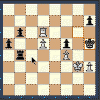

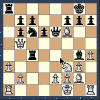
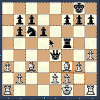

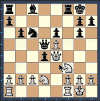
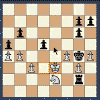



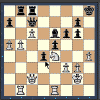

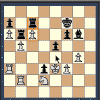
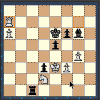
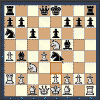
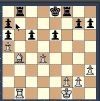


Gadgeteer Comment Policy - Please read before commenting
I’ve had one of these for about 2 years: its a robust gadget. It’s withstood rain, forest tracks, beach and general wear and tear. It has an optional heart monitor strap which also wirelessly sends data to the watch. Finally, there is an optional pod for uploading data to a training website (and makes backup on your PC )
I find it most useful for planning new running routes i.e. making them the right length for my training plan. It’s reliable (i.e. will measure same distance the same on different occasions) and accurate (though needs calibrating as per the calibration plan in the manual to be truly accurate). Cell type battery can be hard to track down, but the company sells a 10 or whatever pack for a good price
Apart from tracking the distance, speed and calorific burn of a run, you can also set it to prompt you to run at a given pace i.e. you set it to beep if you run at a speed outside of a pace range you define.
It helped motivate me to stick with running in the early stages. Finally, its a good conversation starter: I often get asked “What’s that on your wrist?”
John Morrison